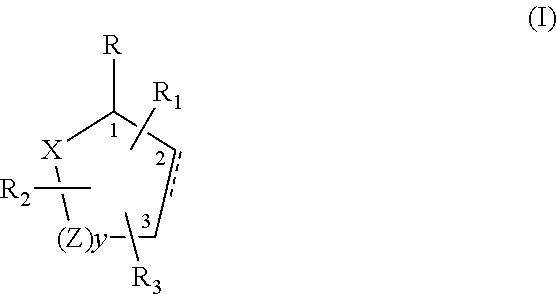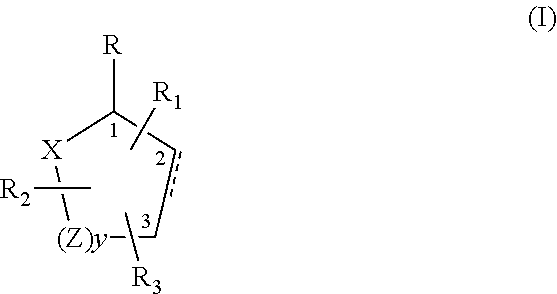Feeding deterrence in agricultural pests such as hemiptera, lepidoptera and coleoptera
a technology for agricultural pests and deterrence, which is applied in the field of feeding deterrence in agricultural pests such as hemiptera, lepidoptera and coleoptera, can solve the problems of large damage, hardship for growers, and high cost of damage, and achieves the effect of improving control methods and reducing mammalian toxicity
- Summary
- Abstract
- Description
- Claims
- Application Information
AI Technical Summary
Benefits of technology
Problems solved by technology
Method used
Image
Examples
Embodiment Construction
[0013]Deterrence of feeding by agricultural pests such as hemiptera, lepidoptera and coleoptera including, but not limited to, stink bugs, codling moth larvae and granary weevils is obtained by contact of the insects with at least one of the compounds of the structure (I)
wherein
R is selected from —OH, ═O, —OC(O)R4, —OR6, and —(OR6)2, wherein each R6 is independently selected from an alkyl group containing from 1 to 4 carbon atoms and R4 is a branched or straight chain, saturated or unsaturated hydrocarbyl group with zero to two double bonds and from 1 to 15 carbon atoms;
X is O or CH2 with the proviso that when X is O R can only be ═O;
each Z is independently selected from (CH) and (CH2);
y is a numeral selected from 1 and 2;
R1 is selected from H or a branched or straight chain, saturated or unsaturated hydrocarbyl group with zero to two double bonds and from 1 to 15 carbon atoms;
R2 is selected from H and a branched or straight chain, saturated or unsaturated hydrocarbyl group with zer...
PUM
| Property | Measurement | Unit |
|---|---|---|
| structure | aaaaa | aaaaa |
| ring structure | aaaaa | aaaaa |
| width | aaaaa | aaaaa |
Abstract
Description
Claims
Application Information
 Login to View More
Login to View More - R&D
- Intellectual Property
- Life Sciences
- Materials
- Tech Scout
- Unparalleled Data Quality
- Higher Quality Content
- 60% Fewer Hallucinations
Browse by: Latest US Patents, China's latest patents, Technical Efficacy Thesaurus, Application Domain, Technology Topic, Popular Technical Reports.
© 2025 PatSnap. All rights reserved.Legal|Privacy policy|Modern Slavery Act Transparency Statement|Sitemap|About US| Contact US: help@patsnap.com



